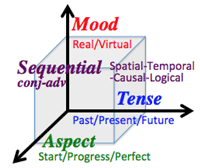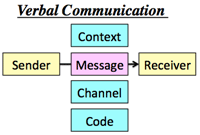 |
Invitation to Semantics
|
Cat: IT |
Yoshihiko Ikegami (池上嘉彦) |
11805u/18211r |
Title
Invitation to Semantics
記号論への招待
Index
Tag
; Adage; Aesthetic expression; Articulation; Artistic semantics; Aspect; Connotation; Context; Four functions of message; Hypothetic inference; Make known; Mood; Motivated sign; Phonemic-phonetic; Ratiocination; Semiotics; Sequentiality of information; Signifiant & signifie; Signification; Silent language; Tense; ;
Why?
- This is a resume of "Invitation to Semantics" in wanami-shinsho.
- This book is just like one of falling scales from the eyes. Why not have read such a book before learning foreging languages.
- 岩波新書「記号論への招待」のレジメ
- 正に眼からウロコみたいな本である。外国語を学ぶ前にまずこの本を読むべきであった。
Key
phrase
Remarks
>Top 0. Preface:
- Lots of interdisciplinary domains pay close attentions to semantics as an analysis of communication, which covers not only official reports or articles but also various writing including literature, advertisement, poem, anecdote, etc. It would give the answer what is communication.
- Here, I will try to summarize key words in a style of Mind-map for the first time.
0.
序:
- 多くの学際領域が、コミュニケーションを分析する上で、記号論に注目している。そのコミュニケーションは公的な報告や論文のみならず、文学、広告、詩文、ジョークなど多方面を含む。
- 初の試みだが、Mind-map風のキーワードとして要約してみる。
>Top
1. Rediscovery of words:
- Language as a cultural symbol:
- as a way of thinking
- constraint of expression
- Aesthetic expression:
- creative expression beyond constraint
- Language is a cultural model:
- A Culture as a language
- A language is a culture
- Silent language: time can speak, and space can speak.
- Picture, Film, and story:
- poem <Gk: poiein, to create
- word > sentence > story
- fantasy, mythology, and dream
- marriage, city, architecture
- >Top Signification:
- expression
- transmission
- conveniences
- Language = Spirit
1.
ことば再発見:
- 文化の象徴としての言語
- 思考様式
- 美的表現:
- 文化のモデルとしての言語
- 言語としての文化
- 言語は文化
- 沈黙の言語
- 時は語る
- 空間も話す
- 絵画、映画、物語
- 詩の語源は創造する
- 語>文>物語
- 幻想、神話、夢
- 婚姻、都市、建築
- 意味作用
- 表現
- 伝達
- 慣習
- 言語=精神
>Top 2. Communication:
- Communicate = make known < L: communicatus; common + ate
- Code:
< document formed from wooden tablet
- a system of signals or symbols; includes vocabulary and grammar
- Semiotics:
- Syntactic:
dealing with the formal relations between signs or expressions in abstraction from their signification and their interpreters.
- Semantics:
dealing with the relations between signs and what they refer to and including theories of denotation, extension, naming, and truth
- Pragmatics:
dealing with the relation between signs or linguistic expressions and their users
- Symbolic Logic = above 1+2
- >Top Context: < L: contextus ; weaving together of words;
- the parts of a discourse that surround a word or passage and can throw light on its meaning.
- code-dependent
- context-dependent:
- poetic expression, child communication
- >Top ratiocination:
the process of exact thinking
- code-dependent + decoding + senders-centric
- context-dependent + interpretation + receiver-centric
- >Top adage:
a saying often in metaphorical form that embodies a common observation
- maxim: a general truth, fundamental principle, or rule of conduct
- superstition:
a belief or practice resulting from ignorance, fear of the unknown
- >Top Hypothetic inference:
inferring
a specific from
conclusion based on general principles
- deduction:
inference by reasoning from the general to the specific
- induction:
deriving general principles from particular facts or instances
2. コミュニケーション
:
- Communicate: 知らしめる <共通の
- コード:
- 記号論
- 統辞論:記号と記号の結合
- 意味論:記号とその指示物の関係
- 実用論:記号とその使用者の関係
- 記号論理学=上記1+2
- コンテクスト:
- コード依存型
- コンテクスト依存型
- 推論
- コード依存+解読+発信者中心
- コンテクスト依存+解釈+受信者中心
- 屁理屈
- ことわざ
- 格言、金言
- 迷信
- 仮説的推論:
一般規則に基づいて、帰結から事例を推定する
- 演繹:
一般規則に基づいて、一つの事例からある帰結を引き出す
- 帰納:
事例と帰結が与えられていて、一般規則を導き出す
>Top 3. Code and Signification:
- transmittance and signification
- code and symbolic function
- signifiant and signifie
- signifiant: visible; a spelling or pronunciation of "cat"
- signifie: invisible; concept or image of "cat"
- >Top Articulation:
- the act of vocal expression; utterance or enunciation
- articulation and differentiation
- phonemic:
- phoneme: the smallest phonetic unit in a language that is capable of conveying a distinction in meaning
- phonetic:
- features of pronunciation that are not phonemically distinctive in a language, as aspiration of consonants or vowel length in English
- Eg.: "Ginga" : <ng> or <n>
- double articulation (duality of structure)
- articulated to meaningful words
- articulated to meaningless sounds
- >Top motivated sign and immotive sign:
- icon: mimetic word and imitative word
- index:
- symbol
- >Top Sequentiality of information: (by conjunction, adverb)

- spatial
- temporal
- causal
- logical
- Top tense:
- past
- present
- future
- Top mood:
- real
- virtual
- Top aspect:
- start-up
- progressive form
- perfect form
- consistency of sentence:
- topic - development - conclusion
- introduction - development - turn - conclusion
- frame : something composed of parts fitted together and united
- scheme: a plan or program of action
- slot: a narrow opening or groove
- filler: a substance added to a product
- text: original words and form of a written or printed work
- 'Text' in Japanese message is relatively less independent from 'context.'
3.
記号と意味作用:
- 伝達と意味作用
- 記号と記号機能
- 記号表現と記号内容:
- 記号表現:"cat"という綴りや発音
- 記号内容:"cat"の示す猫のイメージ
- 分節:
- 分節と差異作用
- イーミック <phonemic 音韻論的
- エティック <phonetic 音声学的
- 二重分節 (構造の二重性):
- 第一分節:文は意味のある語から成る
- 第二分節:語は意味のない音から成る
- 有契記号、無契記号:
- イコン性:擬声語、擬態語
- インデックス性
- シンボル性
- 情報の連続性: (接続詞や副詞)
- 空間的
- 時間的
- 因果的
- 論理的
- 時制:
- 過去
- 現在
- 未来
- 法:
- 現実
- 非現実
- 相:
- 開始
- 進行中
- 終了
- 文の整合性:
- トピック→展開→結論
- 起承転結
- フレーム
- スキーム
- スロット
- フィルター
- テキスト
- 日本語のメッセージの「テキストは」、相対的に「コンテキスト」からの自立性が弱い
>Top 4. Expansion of semantics:
- Human being is an animal which make structuring and ordering the external world. This is a challenge of making nature into culture.
- making a virtual world beyond reality by manipulating codes, pursuing infinite liberty beyond its physical limit.
- from aesthetic function of codes to artistic semantics:
- function of codes:
what function is mostly intended when you use language (codes):
- referential function:
- expressive function:
- conative function:
- aesthetic function: emancipate message from codes.
- >Top Four functions of messaging:

- contents
- sender
- receiver
- beauty function and creativity:
- how to send the message
- tension between code and message
- ambiguity
- disparity and commonality
- motivated sign
- tautology
- idiomaticity
- recurrence of old words
- Cultural activity:
- to make up 'meaningfulness' for humans.
- notation:
act, process, method, or instance of representing by a system or set of marks, signs, figures, or characters.
- Top connotation:
an idea or meaning suggested by or associated with a word or thing
4. 記号論の拡がり:
- 人間は外部世界を構造化・秩序化する動物
- 記号の美的機能から芸術記号論:
- 記号機能
:言語 (コード)を使用する際に、その機能が中心的に関与するか
- 指示機能
- 表出機能
- 訴え機能
- 美的機能
- メッセージの4つの機能:
- 伝達内容
- 発信者
- 受信者
- 美的機能と創造性
- いかに伝えるか
- コードとメッセージの緊張関係
- 曖昧さ
- 差異と共通性
- 有契記号
- 反復
- イディオム化
- 古い言葉への回帰
- 文化的営みとは:
- 人間にとって"意味あるもの"を作り出すこと
- 表示義;表記・記号の体系
- 共示義:言外の意味、含意
Comment
- Semantics is the study of meaning, covering wide range of studies.
- Word, phrase, clause and sentence are structured. We must understand such hierarchical relation between words.
- Also there are such relations between linguistic units as; homonymy, synonymy, antonymy, polysemy, monosemy, paronyms, hypernymy, hyponymy, meronymy, holonymy.
- 記号論は、意味に関する広範な研究分野である。
- 語、句、節、文は構造化している。我々はこれらの語句間の階層関係を理解しなければならない。
- また個々の言葉にはさまざまな関係がある。即ち、同音異義語、同義語、反意語、多義語、単義語、同根語、上位語、下位語、換喩語、全体・部分関係
Title |
Invitation to Semantics |
記号論への招待 |
|---|---|---|
Index |
||
Tag |
; Adage; Aesthetic expression; Articulation; Artistic semantics; Aspect; Connotation; Context; Four functions of message; Hypothetic inference; Make known; Mood; Motivated sign; Phonemic-phonetic; Ratiocination; Semiotics; Sequentiality of information; Signifiant & signifie; Signification; Silent language; Tense; ; | |
Why? |
|
|
Key phrase |
Remarks |
>Top 0. Preface:
|
0. 序:
|
>Top 1. Rediscovery of words:
|
1. ことば再発見:
|
>Top 2. Communication:
|
2. コミュニケーション :
|
>Top 3. Code and Signification:
|
3. 記号と意味作用:
|
>Top 4. Expansion of semantics:
|
4. 記号論の拡がり:
|
Comment |
|
|